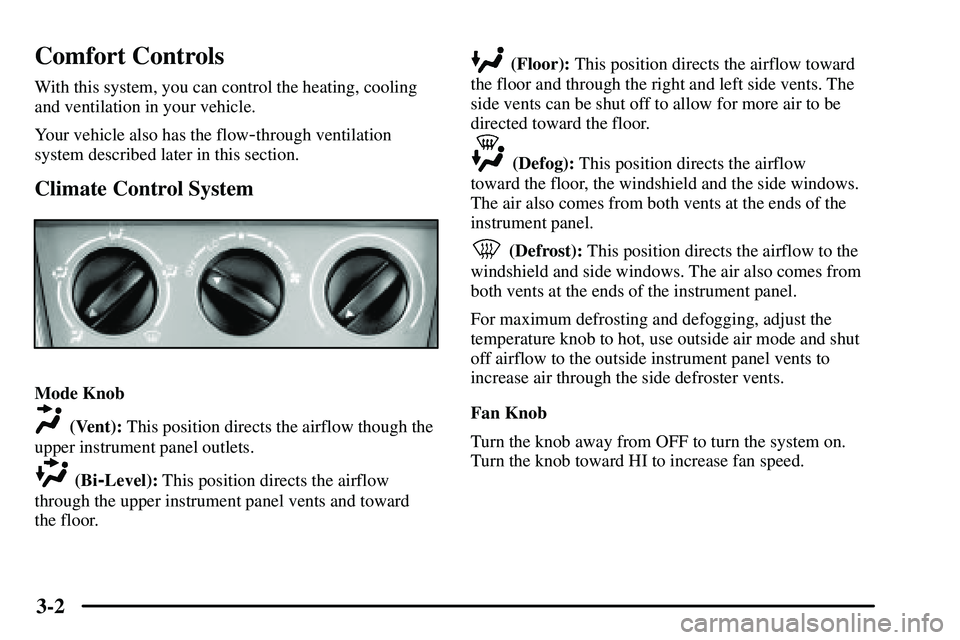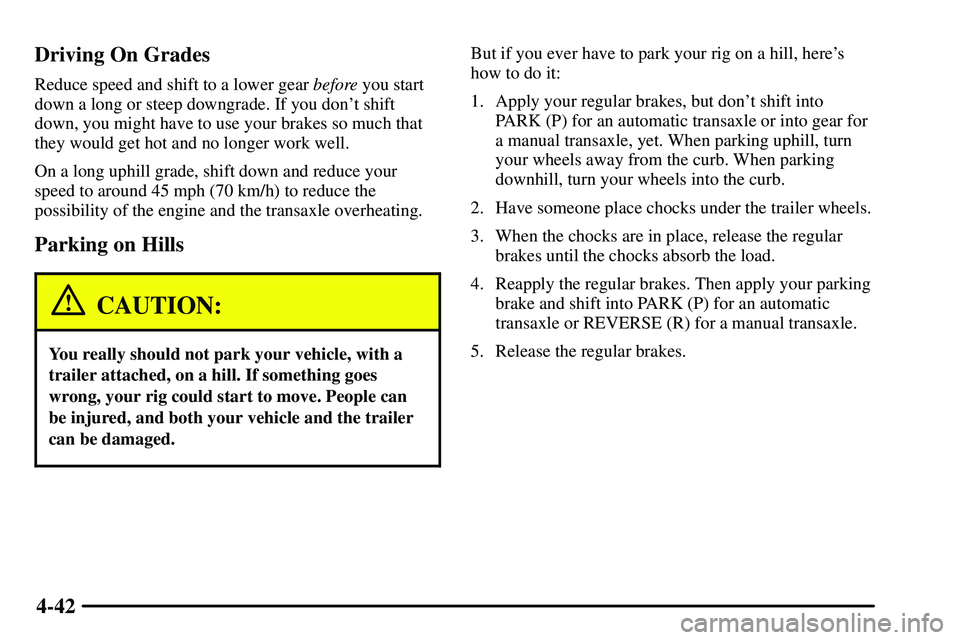Page 76 of 381

2-12
Liftgate/Liftglass
CAUTION:
It can be dangerous to drive with the
liftgate/liftglass open because carbon monoxide
(CO) gas can come into your vehicle. You can't
see or smell CO. It can cause unconsciousness
and even death.
If you must drive with the liftgate/liftglass open
or if electrical wiring or other cable connections
must pass through the seal between the body and
the liftgate/liftglass:
�Make sure all other windows are shut.
�Turn the fan on your heating or cooling
system to its highest speed and select the
control setting that will force outside air
into your vehicle. See ªComfort Controlsº
in the Index.
�If you have air outlets on or under the
instrument panel, open them all the way.
See ªEngine Exhaustº in the Index.
Liftgate/Liftglass Release
To open the liftgate using your key do the following:
�To unlock the liftgate, insert the key into the keyhole
and turn it counterclockwise.
When closing the liftgate, you can use the handle to
pull it down.
�To lock the liftgate, turn the key clockwise to the
first position.
Page 117 of 381
2-53
Ashtrays and Cigarette Lighter
NOTICE:
Don't put papers and other things that burn into
your ashtray. If you do, cigarettes or other
smoking materials could set them on fire, causing
damage.
To use the lighter, push the lighter in all the way and let go.
When it's ready, it will pop back out by itself. If the engine
is not running, the key must be in ACC to use the lighter.
NOTICE:
Don't hold a cigarette lighter in with your hand
while it is heating. If you do, it won't be able to
back away from the heating element when it's
ready. That can make it overheat, damaging the
lighter and the heating element.
Your vehicle has a removeable ashtray that sits in your
front cupholder in the center console storage area.
Sun Visors
To block out glare, you can swing down the visors.
You can also swing them to the side.
Visor Vanity Mirror
Swing down the driver's sun visor and lift the cover to
expose the vanity mirror.
Page 132 of 381

2-68
Canada
This gage shows the engine coolant temperature. If the
gage pointer moves into the red area, your engine is too
hot! It means that your engine has overheated. If you
have been operating your vehicle under normal driving
conditions, you should pull off the road, stop your
vehicle and turn off the engine as soon as possible.
In ªProblems on the Road,º this manual shows what to
do. See ªEngine Overheatingº in the Index.
Malfunction Indicator Lamp
(Check Engine Light)
United States Canada
Your vehicle is equipped with a computer which
monitors operation of the fuel, ignition and emission
control systems.
This system is called OBD II (On
-Board
Diagnostics
-Second Generation) and is intended to
assure that emissions are at acceptable levels for the life
of the vehicle, helping to produce a cleaner
environment. The CHECK ENGINE light comes on to
indicate that there is a problem and service is required.
Malfunctions often will be indicated by the system
before any problem is apparent. This may prevent more
serious damage to your vehicle. This system is also
designed to assist your service technician in correctly
diagnosing any malfunction.
Page 141 of 381
3-
3-1
Section 3 Comfort Controls and Audio Systems
In this section, you'll find out how to operate the comfort control and audio systems offered with your vehicle.
Be sure to read about the particular systems supplied with your vehicle.
3
-2 Comfort Controls
3
-2 Climate Control System
3
-3 Air Conditioning
3
-4 Heating
3
-4 Defogging and Defrosting
3
-5 Rear Window Defogger
3
-6 Ventilation System
3
-7 Audio Systems
3
-7 Setting the Time
3
-8AM-FM Stereo with Compact Disc
Player with Equalization and Radio
Data System (RDS)3
-15 AM-FM Stereo with Six-Disc Compact
Disc Player with Equalization and Radio
Data System (RDS) (Option)
3
-25 Navigation/Radio System (Option)
3
-26 Understanding Radio Reception
3
-27 Tips About Your Audio System
3
-28 Care of Your Compact Discs
3
-28 Care of Your Compact Disc Player
3
-28 Fixed Mast Antenna
Page 142 of 381

3-2
Comfort Controls
With this system, you can control the heating, cooling
and ventilation in your vehicle.
Your vehicle also has the flow
-through ventilation
system described later in this section.
Climate Control System
Mode Knob
(Vent): This position directs the airflow though the
upper instrument panel outlets.
(Bi-Level): This position directs the airflow
through the upper instrument panel vents and toward
the floor.
(Floor): This position directs the airflow toward
the floor and through the right and left side vents. The
side vents can be shut off to allow for more air to be
directed toward the floor.
(Defog): This position directs the airflow
toward the floor, the windshield and the side windows.
The air also comes from both vents at the ends of the
instrument panel.
(Defrost): This position directs the airflow to the
windshield and side windows. The air also comes from
both vents at the ends of the instrument panel.
For maximum defrosting and defogging, adjust the
temperature knob to hot, use outside air mode and shut
off airflow to the outside instrument panel vents to
increase air through the side defroster vents.
Fan Knob
Turn the knob away from OFF to turn the system on.
Turn the knob toward HI to increase fan speed.
Page 144 of 381

3-4 Heating
For the quickest results, press the recirculate button
and move the mode knob to the floor setting. Turn the
temperature knob clockwise for warmer air and turn the
fan knob toward HI. You should switch to outside air
once in a while to avoid stale air and fogging windows.
To prevent cold air from blowing in and to increase
air flow to the floor area, you may close the outer
instrument panel vents.
You may want to use bi
-level mode on cool but sunny
days. This setting directs outside air toward your body
and warmer air toward your feet. Using outside air, turn
the mode knob to bi
-level. Turn the temperature knob
counterclockwise and the fan knob toward HI.
Defogging and Defrosting
When the mode knob is turned to either the defog or
defrost mode, outside air will be selected automatically.
Outside air will clear the windshield more quickly.
Turn the temperature knob clockwise and the fan knob
toward HI. When the windshield is clear, turn down
the fan speed.
If you wish to return to the recirculate mode, the
recirculate button can be set when the mode knob is
set on full defog or full defrost. The indicator light will
come on.
�Recirculate cannot be set partway between floor and
defog, and
�recirculate cannot be set partway between defog
and defrost.
When the mode knob is turned to another position,
outside air will be selected automatically. To defog the
windshield and side windows, use outside air and turn
the mode knob to defog.
Page 146 of 381
3-6 Ventilation System
For mild outside temperatures, when very little heating
is required, you can still direct outside air through
your vehicle.
Use outside air and turn the mode knob to vent. Turn
the temperature knob to a comfortable setting and the
fan knob toward HI.
Constant airflow through the side vents is normal in all
airflow modes. To optimize the effectiveness of your
system in the floor, defog, or defrost modes, close the
outboard vents.
Your vehicle's flow
-through ventilation system supplies
outside air into the vehicle when it is moving. Outside
air will also enter the vehicle when the heater or the air
conditioning compressor is running and the comfort
control system is circulating outside air.
Your vehicle has air outlets
that allow you to adjust the
direction of airflow.
You can direct the airflow side
-to-side by turning the
vents. Airflow comes out of the vents on defrost, defog
and floor positions at a reduced flow.
Page 210 of 381

4-42 Driving On Grades
Reduce speed and shift to a lower gear before you start
down a long or steep downgrade. If you don't shift
down, you might have to use your brakes so much that
they would get hot and no longer work well.
On a long uphill grade, shift down and reduce your
speed to around 45 mph (70 km/h) to reduce the
possibility of the engine and the transaxle overheating.
Parking on Hills
CAUTION:
You really should not park your vehicle, with a
trailer attached, on a hill. If something goes
wrong, your rig could start to move. People can
be injured, and both your vehicle and the trailer
can be damaged.
But if you ever have to park your rig on a hill, here's
how to do it:
1. Apply your regular brakes, but don't shift into
PARK (P) for an automatic transaxle or into gear for
a manual transaxle, yet. When parking uphill, turn
your wheels away from the curb. When parking
downhill, turn your wheels into the curb.
2. Have someone place chocks under the trailer wheels.
3. When the chocks are in place, release the regular
brakes until the chocks absorb the load.
4. Reapply the regular brakes. Then apply your parking
brake and shift into PARK (P) for an automatic
transaxle or REVERSE (R) for a manual transaxle.
5. Release the regular brakes.